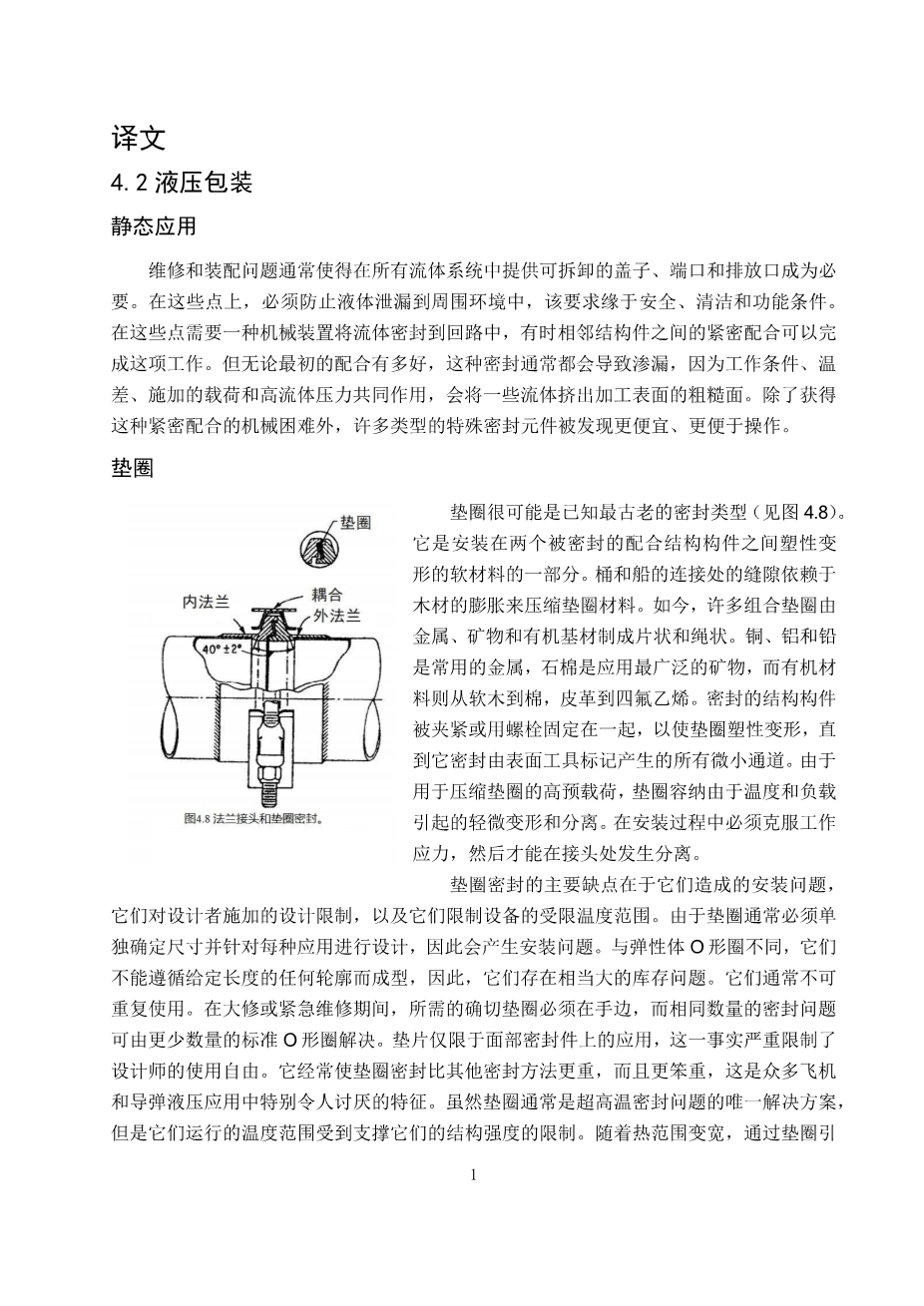4.2. HYDRAULIC PACKINGS
Static Applications
Servicing and assembly problems usually make it necessary to provide removable covers, ports, and drains in all fluid systems. At these points, the fluid must be restrained from leaking to the surroundings. This requirement arises from safety, cleanliness, and functional conditions. A mechanical means is needed to seal the fluid into the circuit at these points. Sometimes a close fit between adjacent structural members does this job. Seepage usually results from such a seal no matter how good the fit was initially; service conditions, temperature differences, applied loads, and high fluid pressures all work together to squeeze some fluid past the asperities of machined surfaces. Apart from the mechanical difficulties of obtaining such close fits, special sealing elements of numerous types have been found to be much cheaper and more convenient to handle.
Gaskets
The gasket is most likely the oldest type of seal known (see Fig.4.8).It is a section of a soft material plastically deformed upon installation between the two mating structural members which it is to seal. The caulking of seams in barrels and ships relied upon the swelling of the wood to compress the gasket material. Nowadays many composition gaskets are made in sheet and rope form out of metallic, mineral, and organic base material. Copper, aluminum, and lead are commonly used metals. Asbestos is the most widely applied mineral, while organic materials ranging from cork to cotton and leather to tetrafluoroethylene are used. The sealed structural members are clamped or bolted together so as to deform the gasket plastically until it seals all the minute passages created by surface tool marks. A gasket accommodates slight deformations and separations due to temperatures and loads because the high preloads used to compress the gasket during installation must be overcome by working stresses before separation can occur at the joint.
The chief drawbacks of gasket seals are found in the installation problems they create, the design limitation they impose on the designer, and the restricted temperature range to which they confine equipment. Installation problems are created by the fact that gaskets usually must be individually sized and designed for each application. Unlike elastomer O rings, they cannot be shaped to follow any contour of given length. Consequently they present a considerable inventory problem. They normally are not reusable. During overhaul or emergency repair, the exact gaskets needed must be on hand, while an equal number of seal problems can be served by a much smaller number of standard O rings. Gaskets are confined to applications on face seals. This fact severely restricts the designer#39;s freedom of their use. It often makes gasket applications heavier and bulkier than other sealing methods, a particularly objectionable feature in the numerous aircraft and missile hydraulic applications. Although gaskets are frequently the only solution for very-high-temperature seal problems, the range of temperatures through which they operate is limited by the structural strength backing them up. As the thermal range widens, thermal stresses introduced via the gasket increase to the point of making structures unreasonably heavy. In general, gasket seals are found in commercial hydraulic equipment of limited temperature range, they are essential in very-high-pressure applications where elastomers become marginal because of their lower physical strength. Frequently gaskets are the only solution to very-high-temperature applications. It is felt, nevertheless, that gaskets are decreasing in use and giving way to elastic seals both of the elastomer and metallic type.
Several gasketlike applications are popular. One is the flare fitting in which the tube and fitting resemble a gasket joint. Actually the two halves of the fitting utilize the flared section of the tubing like a gasket (see Fig.4.1). When properly designed and applied, such fittings are capable of withstanding all vibration, temperature, and pressure conditions currently found in missile applications. Reference should be made to a standard catalog of flare tube fittings for design data. Similarly the automotive swage fittings and compression lock. Fittings are forms of gasket seals of wide application and usefulness. Most of these types of tube fittings are preferred to the threaded pipe joints-although there still exists a large amount of equipment in the commercial and marine field which adheres to the pipe standard.
'O' Rings
The seal of widest applicability is without doubt the elastomer ring with all its varied cross-sectional shapes, sizes, and composition. At this point we shall confine the discussion to physical shapes and the geometry of the applications, since the body of knowledge concerned with properties of elastomers is large enough to be treated separately in greater detail. The elastomer seal differs from the gasket in principle, in that it relies on the elastic deformation of the seal material (caused by installation or squeeze) to provide a positive initial seal(see Fig.4.9). Further it uses the fluid pressure against which it seals to activate the seal in service. Although most elastomers experience some plastic set during their useful life, they are usually designed to swell in service.
The combination of these two actions determines the groove size and tolerances. Extensive tables have been compiled showing static installation practice for all types of seals, compounds, and fluids. It is of utmost note extrusion, importance to adhere to these recommendations in the design of a seal installation in order to obtain the desired performance and life. Installation conditions falling outside the range of tabulated data should be discussed with seal manufacturers whose application enginee


英语原文共 11 页
资料编号:[4447]
以上是毕业论文外文翻译,课题毕业论文、任务书、文献综述、开题报告、程序设计、图纸设计等资料可联系客服协助查找。


